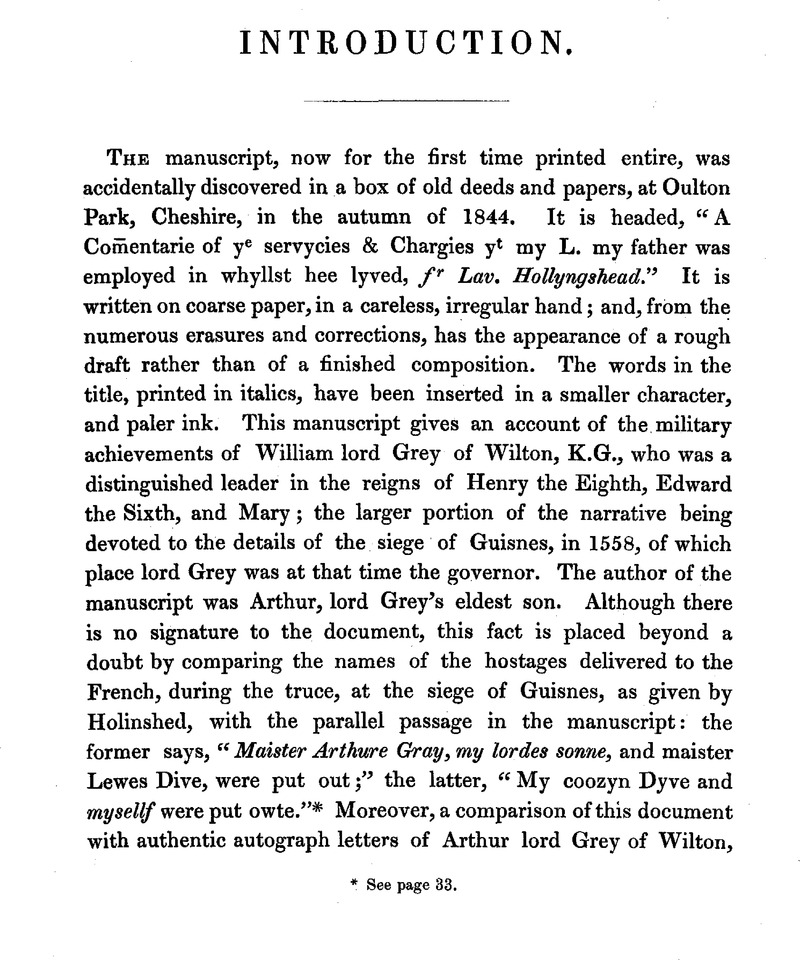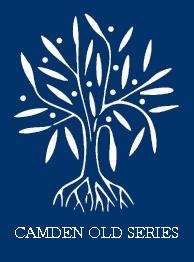Article contents
Abstract

- Type
- Introduction
- Information
- Copyright
- Copyright © Royal Historical Society 1847
References
page v note * See page 33
page vi note * The parallel passages from Holinshed are printed on the same pages with the original.
page vi note † Holinshed's Chronicle, first edit. 1577, p. 1610.
page vii note * Dugdale's Baron, i. 714, 1610.
page vii ntoe † This appointment was not immediately after the taking of Boulogne, but (as stated by the present author, p. 3) on the earl of Surrey's recall, in April, 1546. In the previous year, by the Commission printed in the Appendix No. II. (but which is undated,) lord Grey had been appointed chief captain of the army called “the Crews.” On the 25th August it was determined to transfer this command to the earl of Surrey, and lord Grey was to be appointed Lieutenant of Boulogne in the room of lord Poynings, then recently deceased: “Letteres were addressed to the counsell of Bolloyne signefyinge the appointemente of the lorde Graye to the lieutenancye of that towne, whome they shoulde use at his arrivall as they did the lord Poynings.” At the same time “To the counsell of Callaice was signified his majesties appointemente of the said lord Graye to Bolloyne, and the earl of Surrey to be general as the lord Graye was.” (Register of the Privy Council.) But, a few days after, on the 31st of that month, “Upon letteres from Guisnes the king's majestie was pleased that the lorde Grave should keep his ould charge, and the earl of Surreye goe to Bulloine, which was by letters signified to either place at the full.” A patent (dated Sept. 3) immediately passed the seal, appointing the earl of Surrey lieutenant of Boulogne, and lord Grey, in his turn, superseded the earl in the following April. The correspondence of this period, which is printed in Dr. Nott's life of Surrey, contains the particulars of these changes, and developes some jealousy which existed between the two commanders. In one letter mr. secretary Paget speaks of “sinister means to set your two lordships at variance, to the continual torment, if it so be, of yourselves, and the dangerous hinderance of his majesties affairs.” (p. 215.)
page vill note * Merse, a county of Scotland, called also Berwickshire, obtained the appellation of Merse, or March, because it was one of the borders towards England. Seally's Geogra phical Diet.
page viii note † This is an error of Sir John Hayward, Dugdale's authority.
page ix note * On this occasion he was obliged to sell his ancient castle of Wilton-upon-Wye.
page ix note † He was elected K.G. April 1557, but being at that time a prisoner in France, Garter was sent to notify his election. He was installed on April 19th, 1558, by his proxy, Sir Humphrey Ratclyffe.
page ix note ‡ See “An Instruction for the Lord Grey of Wylton, Warden of the Eat and Middle Marches ageynst Scotland; given by the Quenes Majestie, Jan. 23, 1559.” Haynes' State Papers, vol. i. p. 229.
page x note * Holinshed incorrectly says the 25th. The ceremonial of the funeral, which was Dugdale's authority, has been obligingly communicated by William Courthope, esq. Bouge Croix. See the Appendix, No. XII.
page x note † Cheshunt.
page x note ‡ Dugdale's Baronage, vol. i. page 715.
page xi note * Fatal from the prevalence of the plague.
page xii note * See page 33.
page xii note † Holinshed's Chronicle, first edit. 1577, p. 1807. In the following passage of a curious contemporary work, the wound of Arthur Grey is made a consequence of the bad engineering of Sir William Pelham. “Now to returne where I lefte touching wronge informations pr wante of experience: It fell out within two yeeres that the Queenes Maiestie that nowe is sent her army into Scotland for the expelling of the Frenche Nation from thence, at which time the Frenche did then retire themselues, with some fewe Scots, into the towne of Lieth, for theyr most śafetie vpon the approaching of her Maiesties armie: the L. W. Gray of Wilton, then generall of the sayd armie, it pleased his L. to send the horsemen to the number of 500, to viewe the groundes where the campe might best be placed the nexte daie; and Sir William Pelham, beeing then captaine of the pyoners and trench maister, went also to see where he might best begin to intrench: I seeing him going about the same, and notwithstanding I had no acquaintaunce of him, and yet knowing that hee had neither serued in Fraunce, nor with the Emperour, of goodwill that I bare vnto the seruice, I wente vnto him in courteous manner and saide, Maister Pelham, it were verye good for you to beginne at the foote of this hill, and runne straight to yonder hillocke; whereat he seemed to be offended, and saide that I stoode not charged with these matters—it was his charge and not mine: I was sorie of that I had spoken, considering how vneourteouslie he did accept of my good will. But how did the matter fall out? Before tenne daies, by leauinge his trenche open, the French perceiuing that they might without any let come both on horsebacke and foote, and so did; wheras it cost the Hues of 200 souldiers, and captaine Bartlet taken prisoner, with diuers others; and at the reskew wherof the L. Gray of Wilton that now is, hauing not time to arme him selfe, was shotte through the body with a bullet, so that many thousandes haue dyed of lesser woundes then that was.” From “A breefe discourse concerning the force and effect of all mamtall weapons of fere, etc.... Written by Humfrey Barwich, gentleman, souldier, captaine, et encor pins oultre.” At London. Printed for Richard Oliffe 40 no date. [1591 ?]
page xiii note * Lysons's Buckinghamshire, p. 662.
page xiii note † This ia the Grey crest.
page xiii note ‡ Camden's Britannia.
page xiii note § Lansdowne MSS. No. 7, art. 54, and 18, art. 87: the latter refers to some privileges of the chase disputed by a Mr. Fortescue.
page xiii note | Nichols's Progresses of Queen Elizabeth, vol. i. p. 254. In the Addenda, vol. iii. p. 660, Arthur lord Grey of Wilton is stated to have entertained the Queen at Whaddon also in 1563, the year after his father's death.
page xiii note ¶ History of the Orders of Knighthood, by Sir Harris Nicolas, p. 36.
page xiv note * See Appendix, No. XIII.
page xiv note † Lansd. MS8. 16, art. 21.
page xiv note ‡ See Appendix, No. XIV.
page xv note * See Appendix, No. XV.
page xv note † Appendix, No. XVI.
page xv note ‡ Appendix, No. XVII.
page xvi note * Camden; Holinahed.
page xvi note † Camden.
page xvii note * Appendix, No. XVIII.
page xviii note * Many of Lord Grey's letters to the Home Government at this period are published in the Burghley Papers. See Burghley Papers, by William Murdin, pages 347, 348, 853, 354, 356, 360, 361, 363, 366. The letter given at page 356, dated Dublin, August 30, 1581, is one of great interest, as giving a general view of the effects of Lord Grey's measures for the pacification of Ireland.
page xviii note † Camden.
page xviii note ‡ Cox's Ireland, p. 366.
page xviii note § Todd's Spenser, Introduction, page xlviii. “To the most renowned and valiant Lord, the Lord Grey of Wilton, Knight of the Noble Order of the Garter, — “Most noble Lord, the pillar of my life,
And Patrone of my Muse's pupilage;
Through whose large bountie, poured on me rife,
In the first season of my feeble age,
I now doe live bound yours by vassalage
(Sith nothing ever may redeeme, nor reave
Out of your endlesse debt, so sure a gage);
Vouchsafe, in worth, this small guift to receave,
Which in your noble hands for pledge I leave
Of all the rest that I am tyde t'account:
Rude rymes, the which a rustick Muse did weave
In savadge soyle, far from Parnassa mount,
And roughly wrought in an unlearned loome:
The which vouchsafe, dear Lord, your favourable doome. E, S.”
page xix note * Blattant beast:—
“‘Then since the salvage island I did leave,’
Sayd Arthegal, ‘I such a beast did see,
The which did seeme a thousand tongues to have,
That all in spight and malice did agree,
With which he bay'd and loudly bark't at mee,
As if that he att once would me devoure:
But I, that knew myself from perill free,
Did nought regard his malice nor his powre:
But he the more his wicked poyson forth did poure.’”
page xx note * The manor of Holdenby, or Holmby, in Northamptonshire, belonged at this period to Sir Christopher Hatton.
page xx note † Life and Times of Sir Christopher Hatton, by Sir Harris Nicolas, pages 271 and 385.
page xx note ‡ Appendix, No. XIX.
page xxi note * This passage is borrowed by Fuller, in his Worthies, Buckinghamshire, page 134.
page xxii note * Lord Grey was one of the mourners at the funeral of Francis earl of Bedford, Sept. 14,1585, and the funeral sermon, which was afterwards printed, was dedicated to him by the preacher, Dr. Sparkes.
page xxiii note * See Pedigree, page xxiv
page xxiii note ‡ Vol. ii. page 237.
- 1
- Cited by


